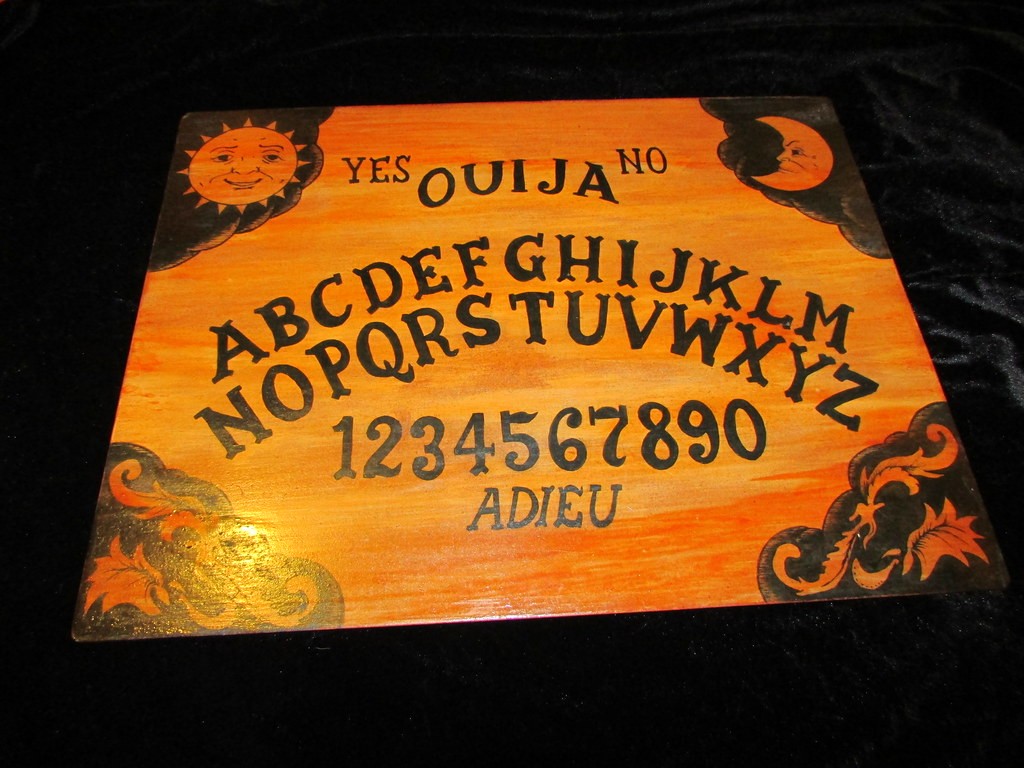Ouija Boards
Ouija board, widely known as a talking board or spirit board, is a device that is used as a medium to ask questions and receive answers and messages from the spirits of the dead. Ouija board is a flat, wooden board with Latin alphabets A-Z, written in two semicircles. Under the alphabets are 0–9 digits written straight. On the top left corner, it reads as “yes” and on the top right corner as “no”.
At the bottom it reads as “goodbye”. A planchette, a heart-shaped wooden piece is then placed on Ouija board as a controller to slide smoothly on the alphabets, digits and messages during a séance (event to meet the dead). Participants lightly place their fingers on the smaller piece known as planchette, which then moves about the board, apparently, due to pressure casted by the spirits to spell out words or sentences.
History of the Ouija Board
The history of the Ouija board begins in the 19th century, when it became extensively popular following the civil war in America. Those, in the denial phase of their grief of losing their loved ones, perceived it as an attempt to speak and connect with the departed. The board, however, was first developed by Charles Kennard and E.C. Reiche in 1890 in Baltimore, Maryland.

There is a constant debate around the validity of the Ouija board. Occults still believe it to be a spiritual phenomenon, which exists beyond doubt. However, the researchers and skeptics label it as pseudoscience and conclude that the board is merely a psychological phenomenon and link its apparent performance to ‘ideomotor effect’.
Ideomotor Effect
According to the Skeptic’s Dictionary, the ideomotor effect is “the influence of suggestion or expectation on involuntary and unconscious motor behavior”. The concept of the ideomotor effect is taken from the terms “ideo” and “motor”, which mean mental representation and physical or muscular movement respectively. It is referred to when merely thinking or mentally visualizing something generates a reflexive muscular action. The muscular reaction is outside of conscious awareness, even if it is of a minute degree. So, the ideomotor effect, also known as the ideomotor reflex, takes place when a subject makes motor movements or motions unconsciously.
Research evidence supports the notion that bodily functions are influenced by the unconscious mind (mind-body connection). Literature explains that the fact that people actually intend to perform an action occurs outside of the conscious awareness. According to Sigmund Freud’s psychoanalytic theory of personality, the unconscious mind is the area of mind, where thoughts, feelings, desires, fears and memories exist outside of the conscious awareness. Freud asserted that even these motives exist underneath the surface of intentional awareness, they have a massive influence on human thought and behavior.
Ideomotor effect is a psychological phenomenon that explains how certain muscular movements, like those on the planchette of Ouija board can be a result of the unconscious mind rather than the conscious mind or any claimed supernatural powers. The ideomotor effect is also evident in different other occurrences like hypnosis, pendulum, dowsing rods and table-tilting, according to psychological research.
Principles of ideomotor effect
Ideomotor effect is based on two principles namely, perceptual induction and intentional induction.
Perceptual induction takes place when people observe other people performing something and imitate similar movements and actions, operating from an unconscious level. Whereas, intentional induction occurs when individuals make movement and actions based on their tendency to achieve a certain desirable outcome. These principles explain how people may tend to move the planchette unintentionally and perceive the motion to be a message from the outside forces.
A study conducted by Mark Edwards, a paranormal expert of The National Geographic Channel shatters all the supernatural beliefs around the Ouija board. Four subjects participated in the experiment to test the Ouija board function to talk to the spirits.

One of the four participants, a girl, actually seemed to be indulging in a meaningful conversation with her late grandfather. However, things took a turn when the experimenter asked the subjects to play again but while being blindfolded. This time around the planchette moved again but it did not produce any meaningful messages.
Implicit Memory and Ouija Board Responses
Implicit memory is the type of memory that uses past events and experiences to retrieve information without deliberately recalling them. People do not realize that they have implicit memories of something because those memories cannot be verbally explained yet they are able to recreate the procedure involved in a certain task like tying shoes, riding a bike or playing guitar.
The researchers investigated the research hypothesis that ideomotor actions depict unconscious information. In a research experiment Gauchou and colleagues found that implicit semantic memory can be reached in the Ouija board related ideomotor behaviors. In the study, the subjects were tricked into believing that they were playing Ouija board with another subject, who in fact was a part of the research team. In reality they were playing moving the planchette alone.
Results depicted that when participants thought they knew the answers; they gave similar answers in voluntary reports as well as on Ouija board. However, when they believed that they were merely guessing the answers, they scored significantly higher on the Ouija board responses. The results depicted that implicit memory can be accessed in tasks involving ideomotor actions.
Ouija Boards and the Ideomotor Effect
In order to understand the mechanisms behind the Ouija board, it is important to understand the power of suggestion and the ideomotor effect. It states that when participants’ experience unintentional muscle movements, influenced by their ideas and expectations, it gives them the illusion of an external connection with the spirits.
According to psychological studies, the Ouija board results are highly dependent on the participant’s past memories and knowledge. The board, however, is not a medium to provide any external messages.
This knowledge validates the perspective that the planchette movements while playing Ouija board are not supernatural but rather muscle movements operated through the ideomotor effect.





